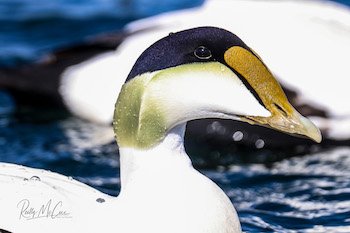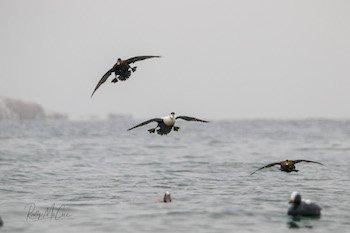Common Eider
 Common Eider (Somataria mollissima) are the most widespread and abundant eider species, breeding further south than any of the others. They’re the largest duck species in the northern hemisphere, too. Six common eider subspecies are recognized, with 4 occurring in North America. North American common eider subspecies are the Atlantic (S. m. dresseri), Pacific (S. m. v-nigra), Northern (S. m. borealis), and Hudson Bay (S. m. sedentaria). Common Eiders are only slightly larger than king eiders. Large, heavy-built ducks with long faces; a roman-nosed profile formed by long orange to yellow bill sloping to tall, black crown. Bill color is racially variable but generally olive-gray, transitioning to yellow on facial area and tip. Nape to upper neck pale green, bisected by white line running into white portions of neck and back. Scapulars long and curved; retails slightly curved forming a small sail on back. Salmon-pink breast. The females have same facial shape as males and usually similarly pale gray bill. Both sexes have yellow legs and feet. Drake common eider don’t achieve prime breeding plumage until third year.
Common Eider (Somataria mollissima) are the most widespread and abundant eider species, breeding further south than any of the others. They’re the largest duck species in the northern hemisphere, too. Six common eider subspecies are recognized, with 4 occurring in North America. North American common eider subspecies are the Atlantic (S. m. dresseri), Pacific (S. m. v-nigra), Northern (S. m. borealis), and Hudson Bay (S. m. sedentaria). Common Eiders are only slightly larger than king eiders. Large, heavy-built ducks with long faces; a roman-nosed profile formed by long orange to yellow bill sloping to tall, black crown. Bill color is racially variable but generally olive-gray, transitioning to yellow on facial area and tip. Nape to upper neck pale green, bisected by white line running into white portions of neck and back. Scapulars long and curved; retails slightly curved forming a small sail on back. Salmon-pink breast. The females have same facial shape as males and usually similarly pale gray bill. Both sexes have yellow legs and feet. Drake common eider don’t achieve prime breeding plumage until third year.
Available Hunts
 Common Eider distribution is widespread through arctic and sub-arctic, ranging southwards to wintering grounds of New England on the Eastern US seaboard, and along the Bering Sea nearest to Alaska on the Pacific side. Pair-bonds are created on wintering grounds, but pairings are not known to be as long as other sea ducks. Resident populations found in coastal areas of the Aleutian Islands, southern Greenland, northern Quebec, and New England. Migratory common eider breeding grounds found along the entirety of coastal Greenland, the northern coasts of Canada, and Alaska. Females alone choose nesting sites, making their ground nests near the sea or near tundra ponds.
Common Eider distribution is widespread through arctic and sub-arctic, ranging southwards to wintering grounds of New England on the Eastern US seaboard, and along the Bering Sea nearest to Alaska on the Pacific side. Pair-bonds are created on wintering grounds, but pairings are not known to be as long as other sea ducks. Resident populations found in coastal areas of the Aleutian Islands, southern Greenland, northern Quebec, and New England. Migratory common eider breeding grounds found along the entirety of coastal Greenland, the northern coasts of Canada, and Alaska. Females alone choose nesting sites, making their ground nests near the sea or near tundra ponds.
Common eiders are marine species, preferring shallower inshore coastal waters with adjacent small islands, estuary mouths. Their diets are primarily made up of crustaceans, mollusks, or sea urchins. As divers, this species will dive to the ocean floor in search of suitable food.
Common eider sociable and can be found in sizable flocks year-round. Remember that only mature breeding birds have prime plumage. The best specimens are taken from pairs than from flocks.
More information: The 4 Subspecies of North America common eiders discussed in greater detail. Excellent summary.







